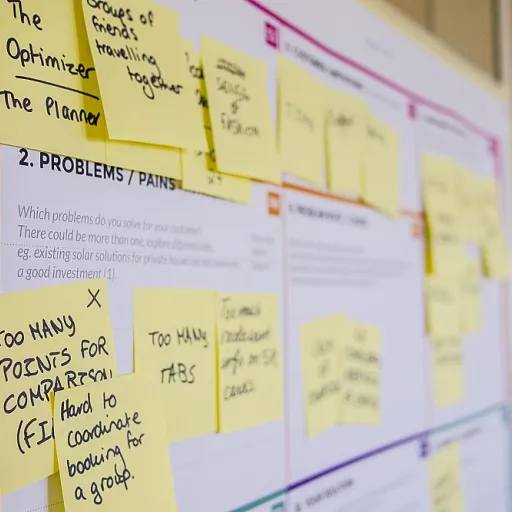
Understanding the boundaries in AI-powered SEO
Recognizing the Value of Boundaries in AI SEO Strategies
In the world of AI-driven search engine optimisation, knowing your limits is not a weakness—it’s a strategic advantage. Competitors who understand the boundaries of artificial intelligence in SEO are better equipped to find the best answers to complex challenges. Just as crossword enthusiasts rely on clues and answers to solve puzzles, successful SEO professionals use their knowledge of AI’s strengths and limitations to guide their efforts. This approach helps avoid the common pitfall of over-optimisation, where chasing every new algorithm update or keyword trend can lead to diminishing returns.
AI tools can process vast amounts of data, identify patterns, and suggest optimisations faster than any human. However, they are not infallible. The best competitors know that AI is only as effective as the data and instructions it receives. For example, relying solely on automated recommendations can sometimes lead to generic content that fails to engage people or meet the nuanced needs of a target audience. Recognizing these limits allows teams to focus their skills where they matter most—on creative strategy, brand voice, and user experience.
- AI can quickly generate lists of relevant keywords, like "crossword clue," "nyt answers," or "word games," but it takes human insight to choose which ones truly align with your brand and audience.
- Competitors who know their limits use AI to handle repetitive tasks, freeing up time for deeper analysis and creative problem-solving.
- Understanding boundaries helps avoid the trap of chasing every "crossword answer" or "clue" that appears in data, focusing instead on what drives real results.
Much like solving a challenging crossword puzzle, excelling in AI-powered SEO requires a balance of automation and human expertise. By recognizing where AI excels and where human judgment is essential, competitors can adapt to evolving search engine algorithms and measure success with realistic expectations. For more on how clear brand guidelines can support this balance, check out this resource on effective brand guidelines for influencer collaborations.
The role of algorithmic transparency in setting realistic goals
Why Transparency Matters in AI SEO
Algorithmic transparency is a crucial clue for competitors who know their limits in AI-driven search engine optimisation. When you understand how AI models make decisions, you can set realistic goals and avoid chasing the wrong answer. Search engines like Google and Bing use complex algorithms, but they also provide hints—like ranking factors and updates—that act as clues in a crossword puzzle. The best competitors pay attention to these clues, using their skills to find the right answer without overreaching.
- Transparency helps you know your limits. If you understand what the AI can and cannot do, you avoid wasting time on tactics that no longer work.
- Competitors who know their limits focus on the clues provided by search engines, rather than guessing or relying on outdated answers.
- Algorithmic transparency allows you to share insights with your team, improving collective skills and helping everyone find the best answer to each SEO puzzle.
People often treat SEO like a crossword, searching for the right word or answer. But without understanding the rules, it’s easy to get stuck. Competitors who know their limits use transparency as a guide, finding the best clues and answers without over-optimising. This approach is especially important as search engine algorithms evolve over time, with new crossword clues and answers appearing every month—whether it’s September, November, or any other time of year.
For those looking to enhance their inbound strategy and stay ahead in the world of AI-powered SEO, understanding the role of transparency is key. Learn more about enhancing your inbound strategy to complement your AI-driven efforts.
Balancing automation with human expertise
Why Human Insight Still Matters in AI SEO
Even as artificial intelligence transforms search engine optimisation, the best competitors know their limits and the value of human expertise. AI can process massive data sets, spot patterns in crossword clues, and suggest answers faster than any person. However, it lacks the nuanced understanding that people bring to word games, crossword puzzles, and SEO strategy.
Here’s where the balance comes in:
- Contextual Understanding: AI might find the answer to a crossword clue or suggest the best keywords, but it can miss subtle meanings, cultural references, or the intent behind a search. Human skills are essential for interpreting these clues and adapting strategies accordingly.
- Creative Problem-Solving: While AI can generate a list of answers or optimise content, it often struggles with creative thinking. People excel at connecting seemingly unrelated clues, finding new angles, and crafting engaging content that resonates with both users and search engines.
- Ethical Judgement: Competitors who know their limits understand that not every AI-generated answer or tactic is appropriate. Human oversight ensures that SEO strategies align with ethical standards and avoid practices that could harm reputation or violate guidelines.
- Continuous Learning: Just as crossword enthusiasts improve their skills over time, SEO professionals must keep learning. AI tools can provide clues and answers, but ongoing education and adaptation are vital for staying ahead of evolving algorithms and competitors.
Those who excel in AI-driven SEO are like answer mathletes in a crossword competition. They use AI to find the best answers quickly but rely on their own knowledge to know when to trust the clue and when to dig deeper. This approach helps avoid the pitfalls of over-optimisation and ensures strategies remain effective as search engines evolve.
For businesses aiming to find their edge, integrating AI with human expertise is key. If you’re looking for practical ways to blend automation with hands-on skills, check out these effective marketing strategies for auto shops leveraging web design solutions. This resource demonstrates how combining technology with human insight leads to the best results in competitive environments.
Avoiding common pitfalls of over-optimisation
Recognizing the Risks of Over-Optimisation in AI SEO
When competitors know their limits in AI-driven search engine optimisation, they avoid the trap of over-optimisation. Many people, eager to find the best answer or clue to outperform rivals, push automation and keyword strategies too far. This can lead to penalties from search engines, especially as algorithms become more sophisticated in detecting unnatural patterns. Over-optimisation often results in content that feels forced, repetitive, or irrelevant to real user needs—much like a crossword puzzle filled with words that don’t fit the clues.
- Keyword stuffing: Repeating the same word or phrase, such as "crossword clue" or "nyt answers," can harm rankings instead of helping. Search engines value natural language and context over sheer frequency.
- Automated content traps: Relying solely on AI to generate answers or clues without human review can create generic or inaccurate content. Competitors who know their limits blend automation with their own skills to ensure quality.
- Ignoring user intent: Focusing only on what algorithms want, rather than what people are searching for, can make content less helpful. The best results come from understanding both the technical and human side of SEO.
Just as in crossword puzzles, where finding the right answer requires both logic and creativity, successful SEO means knowing when to use AI tools and when to rely on human expertise. Competitors who know their limits avoid chasing every new trend or overusing automation. Instead, they focus on delivering value, adapting to clues from search engine updates, and refining their approach over time.
By respecting these boundaries, businesses can avoid common pitfalls and build a sustainable SEO strategy that stands the test of time—much like a well-constructed crossword that keeps people coming back for more.
Adapting to evolving search engine algorithms
Staying Ahead of Algorithm Updates
Search engines like Google and Bing are constantly updating their algorithms. For competitors who know their limits in AI-driven search engine optimisation, adapting to these changes is crucial. The best strategies involve monitoring for new clues about algorithm shifts, much like solving a crossword puzzle where every answer helps reveal the bigger picture. People who excel in SEO treat each update as a new crossword clue, using their skills to find the answer and adjust their approach.
- Continuous learning: Competitors know that their limits are not fixed. They regularly review SEO news, analyze ranking changes, and test new tactics to stay current. This helps them avoid being caught off guard by unexpected algorithm changes.
- Data-driven adjustments: By tracking performance metrics, they can spot patterns—like finding the right word in a crossword—that indicate when an algorithm update has impacted their site. This allows for timely tweaks rather than overhauls.
- Balanced approach: Rather than chasing every new trend, these competitors know their strengths and focus on proven strategies. They avoid the temptation to over-optimise, which can lead to penalties, and instead share their time between automation and human insight.
Just as crossword answers require both logic and creativity, adapting to evolving algorithms means blending AI tools with real-world experience. Competitors who know their limits use AI to process large volumes of data, but they rely on human expertise to interpret the clues and find the best answers. This approach helps them maintain strong rankings even as the search landscape shifts.
In summary, the most successful competitors treat each algorithm update as a new puzzle to solve. They respect their limits, use AI to uncover clues, and apply their skills to find the right answer—ensuring they stay ahead in the ever-changing world of search engine optimisation.
Measuring success within realistic expectations
Setting Benchmarks That Reflect Real-World SEO
When competitors know their limits in AI-driven search engine optimisation, they avoid the trap of chasing unrealistic numbers. Instead, they focus on measuring success with benchmarks that reflect the true complexity of search algorithms and the dynamic nature of the digital landscape. This approach is similar to solving a crossword puzzle: you need to find the right answer for each clue, not just fill in words that seem to fit. In SEO, this means tracking metrics that matter, like organic traffic growth, keyword rankings for relevant clues, and improvements in user engagement, rather than obsessing over vanity metrics.
Choosing the Right Metrics for AI-Powered SEO
- Keyword Rankings: Monitor how your site performs for targeted crossword clues and answer phrases that align with your audience’s search intent.
- Organic Traffic: Track the number of visitors arriving via search engines, focusing on quality over quantity.
- Engagement Metrics: Analyze time on site, bounce rates, and interactions, much like evaluating how long people spend solving a crossword clue or puzzle.
- Conversion Rates: Measure how well your SEO efforts turn visitors into customers, similar to finding the best answer to a challenging clue.
Learning from Competitors Who Know Their Limits
Competitors who excel in AI-powered SEO understand that not every answer will be a perfect fit. They regularly review their strategies, compare their performance to industry benchmarks, and adjust their goals as search engine algorithms evolve. This is much like checking the answers in a crossword puzzle to ensure accuracy. By knowing their limits, they avoid over-optimisation and focus on sustainable growth.
Continuous Improvement and Adaptation
Success in AI-driven SEO is not a one-time achievement. It requires ongoing analysis, testing, and adaptation. Just as crossword enthusiasts improve their skills by tackling new puzzles and learning from previous answers, SEO professionals must stay updated with the latest algorithm changes and refine their strategies. This mindset helps them find the best path forward, even when the clues change or new competitors enter the scene.
Ultimately, measuring success within realistic expectations allows teams to celebrate progress, share insights, and build on their strengths. It’s about knowing their limits, learning from each answer, and continuously striving to solve the next big SEO puzzle.













